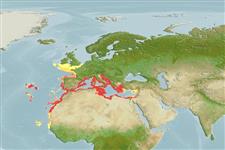Environment: milieu / climate zone / depth range / distribution range
Οικολογία
Θαλασσινό(ά) Υφαλόφιλο(α); εύρος βάθους 1 - 801 m (Ref. 58348), usually 100 - 300 m (Ref. 58348). Subtropical; 52°N - 13°N, 32°W - 36°E
Eastern Atlantic: south of British Isles to Senegal, including the Mediterranean, Azores, Madeira, Canary Islands, and Cape Verde.
Length at first maturity / Μέγεθος / Βάρος / Age
Maturity: Lm 75.5, range 69 - ? cm
Max length : 150 cm TL αρσενικό/απροσδιόριστο; (Ref. 12382); common length : 80.0 cm TL αρσενικό/απροσδιόριστο; (Ref. 3397); μεγ. δημοσιευμένο βάρος: 6.5 kg (Ref. 58348); μεγ. αναφερόμενη ηλικία: 38 έτη (Ref. 58348)
A nocturnal and territorial species (Ref. 12382), commonly lurking in holes, and writhing snakelike through crevices, under rocks or corals. Feeds on fish, crabs and squid (Ref. 12382). It seldom attacks unless provoked (Ref. 3256). A gonochoristic species (Ref. 32169). Utilized fresh and eaten broiled, boiled and baked; the skin can be used for leather (Ref. 9987).
Migrate to offshore waters to spawn (Ref. 98745).
Smith, D.G. and E.B. Böhlke, 1990. Muraenidae. p. 136-148. In J.C. Quero, J.C. Hureau, C. Karrer, A. Post and L. Saldanha (eds.) Check-list of the fishes of the eastern tropical Atlantic (CLOFETA). JNICT, Lisbon; SEI, Paris; and UNESCO, Paris. Vol. 1. (Ref. 4450)
IUCN Red List Status (Ref. 130435)
Threat to humans
Traumatogenic (Ref. 4690)
Human uses
αλιεία: περιορισμένης εμπορικότητας; Ενυδρείο: Δημόσια ενυδρεία
Περισσότερες πληροφορίες
ΑναφορέςΥδατοκαλλιέργειεςΠροφίλ υδατοκαλλιέργειαςΣτελέχοιΓενετικήElectrophoresesΚληρονομικότηταΑσθένειεςΜεταποίησηNutrientsMass conversion
Εργαλεία
Special reports
Download XML
Διαδικτυακές πηγές
Estimates based on models
Preferred temperature (Ref.
123201): 13.1 - 16.2, mean 14.4 °C (based on 181 cells).
Phylogenetic diversity index (Ref.
82804): PD
50 = 0.5010 [Uniqueness, from 0.5 = low to 2.0 = high].
Bayesian length-weight: a=0.00056 (0.00048 - 0.00066), b=3.27 (3.23 - 3.31), in cm total length, based on LWR estimates for this species (Ref.
93245).
Τροφικό Επίπεδο (Ref.
69278): 4.2 ±0.61 se; based on food items.
Ελαστικότητα (Ref.
120179): Πολύ χαμηλό, ελάχιστος χρόνος για διπλασιασμό πληθυσμού > 14 έτη (tmax=38.1; tm=7.1; K=0.078).
Fishing Vulnerability (Ref.
59153): Very high vulnerability (79 of 100).
Climate Vulnerability (Ref.
125649): Moderate to high vulnerability (53 of 100).
Nutrients (Ref.
124155): Calcium = 11.6 [5.8, 23.4] mg/100g; Iron = 0.433 [0.231, 0.841] mg/100g; Protein = 19.3 [17.0, 21.8] %; Omega3 = 0.193 [0.077, 0.603] g/100g; Selenium = 40.8 [19.0, 84.1] μg/100g; VitaminA = 42.5 [12.0, 154.1] μg/100g; Zinc = 0.452 [0.295, 0.682] mg/100g (wet weight);
